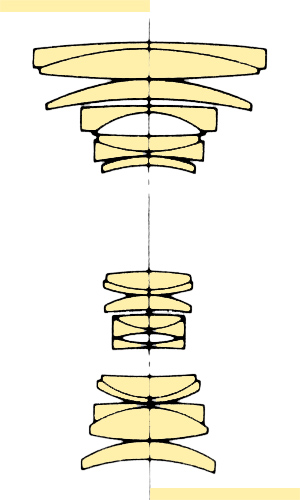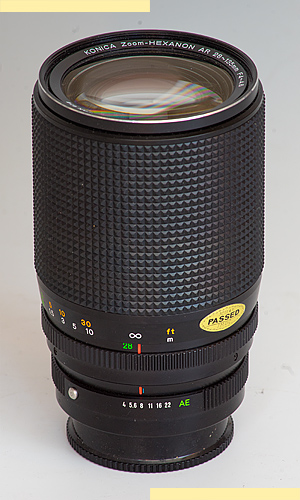Creating a 28-135mm around 1985 was a difficult task, especially if the lens was aimed at demanding professionals. Canon didn't have one (just a 35-105mm), Nikon wisely limited itself to 35-135mm and 35-200mm lenses, and Minolta had just introduced their groundbreaking AF 4-4.5/28-135mm lens. Pentax had their 4/28-135mm introduced in 1984 (a pretty mediocre lens), and then there was Tamron with rather good SP 4-4.5/28-135mm (1983). Now bring in Konica and Tokina ...
The Konica AR 4-4.6/28-135mm is a pretty heavy superzoom computed by Konica and manufactured by Tokina. The lens certainly is one of the most complicated vintage MF lenses ever built, as it has 18 elements in 12 groups. The lens has five (!) independently moving zooming groups. Unlike the Minolta AF 28-135mm, which uses a small group at the rear of the lens for focusing, the Konica 28-135 is focused by moving two front groups independently. This has the advantage of a variable minimum focus distance (MFD). At f=135mm the MFD is 1.5 m, at f=80 mm it is 0.8 m, and in the 28-35mm range it is 0.5 m. Focusing from infinity to 0.5m takes only about 90°, and it "steepnes" is variable as well. Sounds complicated? Manufacturing must have been a nightmare, but the Minolta 28-135mm was a difficult-to-manufacture lens as well (allegedly sold for less than its production price).
The barrel of the AR 28-135m is pretty well made - everything (at least at the outside) is metal, focusing is a bit stiff but precise, and the aperture ring turns reasonably smooth (thank you, Tokina!). While my lens looks like new (and was new old stock when I bought it), something must have come loose inside since I hear a slight "wobble", and objects at infinity are completely unsharp when using the wideangle setting. In addition, using the lens at cold temperatures has caused the front doublet to separate. Therefore all further remarks about the prefomance of the lens refer to test results from my Tokina AT-X 4-4.6/28-135mm!
· At f=28mm, the Konica / Tokina has more CAs and less corner resolution than the Minolta and the Tamron. Center resolution is excellent for all lenses even at f4.
· At f=50mm the Konica / Tokina improves - less CAs and better corners wide open, but the Minolta still is slightly better. Tamron is similar to Konica, but has nearly no CAs. Center resolution is excellent for all three lenses, again.
· At f=90mm the Konica is at its peak - especially at f11 the entire image is really sharp, and no CAs are visible. The Minolta has an even better resolution (particularly at f5.6), but some traces of lateral CAs as well. The Tamron now is slightly weaker than the other two lenses.
· At f=135mm CAs start to kick in - on all three lenses. Wide open, the Konica has quite soft corners - it clears up at f11. The Minolta has similar problems wide open, but is pretty much OK already at f5.6. The Tamron now struggles; even at f11 the corners and bordes are missing some detail.
Oh, and I forgot about the Pentax. Forget it, I must say. It's clearly inferior to the three lenses above, and I mean clearly. That's not due to a "lemon": Other users are reporting the same.
Um 1985 war die Rechnung und Herstellung eines guten 28-135-mm-Zooms eine überaus schwierige Aufgabe, insbesondere wenn das Objektiv für anspruchsvolle Profis gedacht war. Canon hatte kein 28-135mm im Angebot (nur ein nFD 3.5/35-105-mm), Nikon beschränkte sich klugerweise auf 35-135-mm- und 35-200-mm-Objektive mit variabler Lichtstärke, und Minolta hatte gerade sein bahnbrechendes AF 4-4,5/28-135-mm-Objektiv vorgestellt. Pentax brachte 1984 sein 4/28-135 mm auf den Markt (eine nicht gerade überzeugende Konstruktion), und dann gab es Tamron mit dem ziemlich guten SP 4-4,5/28-135 mm (1983). Und nun kommen Konica und Tokina mit einem gemeinsam entwickelten, extrem aufwändig gebauten 28-135er, das mit einer wichtigen Neuerung aufwartet ...
Der Tubus des AR 28-135m ist ziemlich gut verarbeitet – alles (zumindest aussen) ist aus Metall, die Fokussierung ist etwas schwergängig, aber präzise, und der Blendenring lässt sich einigermaßen leichtgängig drehen (Danke, Tokina!). Mein Objektiv sieht zwar wie neu aus, aber im Inneren muss sich etwas gelöst haben, da man ein leichtes «Wackeln» hört und da im Weitwinkelbereich eine Fokussierung auf Unendlich nicht möglich ist. Darüber hinaus hat die Verwendung des Objektivs bei kalten Temperaturen dazu geführt, dass sich das vordere Doublet sich separiert hat und nun regenbogenfarbige Reflexionen zeigt. Daher beziehen sich alle weiteren Ausführungen zur Leistungsfähigkeit des Objektivs auf Testergebnisse mit meinem Tokina AT-X 4-4,6/28-135mm!
· Bei einer Brennweite von 28mm hat das Konica/Tokina 28-135mm stärkere laterale CAs und eine geringere Eck-Auflösung als entsprechenden Objektive von Minolta und Tamron. Die Mittenauflösung ist bei allen Objektiven hervorragend, selbst bei Offenblende
· Bei f=50 mm verbessert sich das Konica/Tokina – bei Offenblende hat es weniger CAs und bessere aufgelöste Ecken als bei 28mm Brennweite. Allerdings ist das Minolta immer noch etwas besser. Das Tamron ähnelt dem Konica, hat aber fast keine chromatischen Aberrationen. Auch hier ist die Mittenauflösung bei allen drei Objektiven hervorragend.
· Bei f=90mm hat das Konica/Tokina seine beste Leistung – vor allem bei f11 ist das gesamte Bild wirklich scharf, und es sind keine CAs sichtbar. Die Minolta hat zwar eine noch bessere Auflösung (insbesondere bei f5,6), aber auch einige Spuren von lateralen CAs. Das Tamron ist jetzt etwas schwächer als die anderen beiden Objektive.
· Bei f=135mm werden chromatische Aberrationen zunehmend störend – dies bei allen drei Objektiven. Bei Offenblende hat das Konica/Tamron recht unscharfe Bildecken; Abblenden auf f11 hilft. Das Minolta AF 28-135mm hat bei Offenblende ähnliche Probleme, ist aber schon ab f5,6 recht brauchbar. Das Tamron hat jetzt sichtbar Probleme; selbst bei f11 fehlen an den Ecken und Rändern die Details.
Zusammengefasst liegt der grosse Vorteil des Konica AR 28-135mm in seiner dualen Fokussiergruppe, die eine variable minimale Fokussier-Distanz erlaubt. Mit 1.5 m bei f=135mm und 0.5m bei f=50mm kann das Konica mit einigermassel praktikablen Werten aufweisen, währendem Minolta und Tamron über den ganzen Brennweitenbereich auf 1.5 m MFD beschränkt waren.
Oh, nun ging das Pentax-A 4/28-135 vergessen. Vergiss es, muss ich sagen. Es ist den drei oben genannten Objektiven deutlich unterlegen, und zwar deutlich. An einer „Zitrone“ liegt das nicht: Dasselbe berichten auch andere Nutzer.
 |
 |
KONICA HEXANON 28-135mm 1:4-4.6 (18 Linsen / 12 Glieder) |

